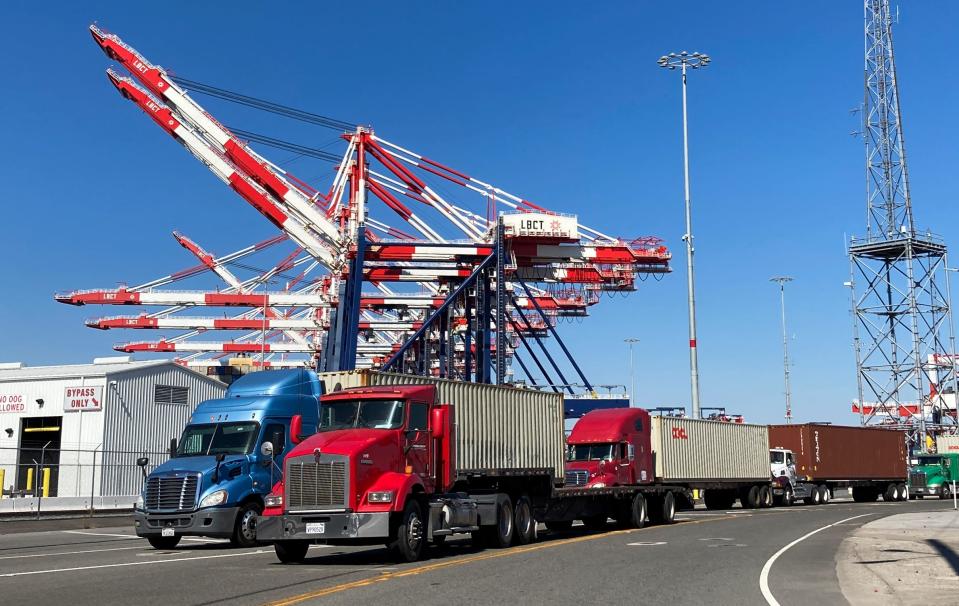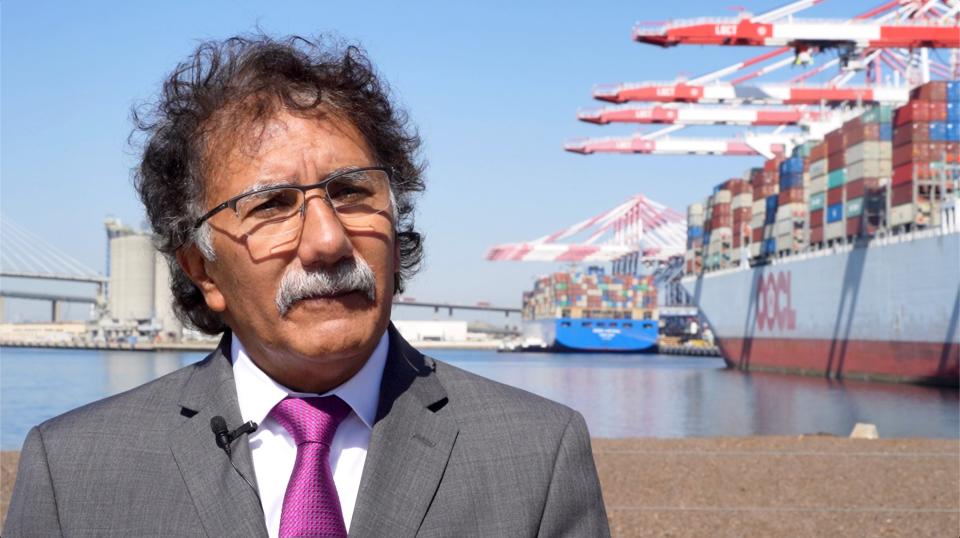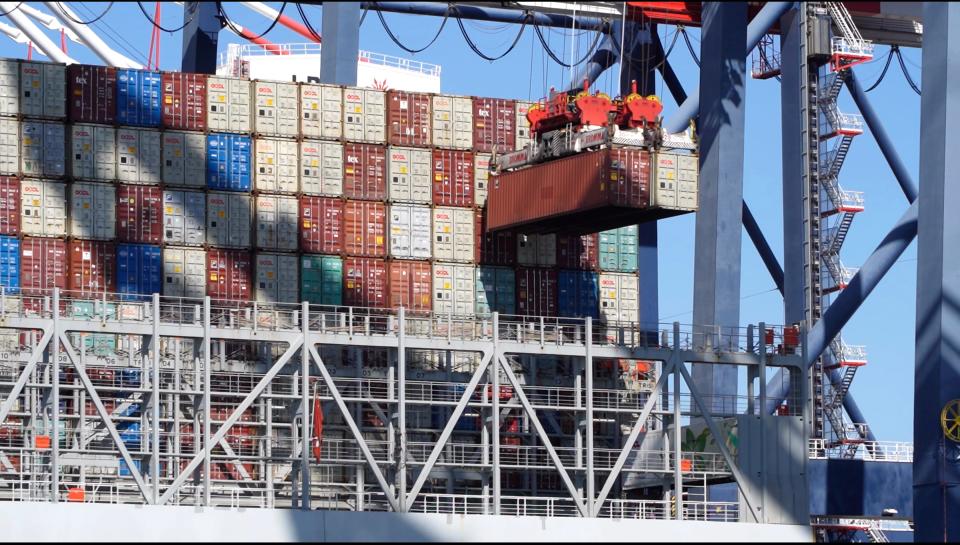Biden says running LA ports 24/7 will help save Christmas shopping. It's not that simple, experts warn.
PORT OF LONG BEACH, Calif. – Last week, President Joe Biden announced a seeming breakthrough in the supply chain bottlenecks that are threatening holiday deliveries, driving up consumer prices and constraining the nation’s recovery from the COVID-19 recession.
The Port of Los Angeles – at the nerve center of the logjam – will operate around the clock to help clear out some of the hundreds of thousands of shipping containers from Asia stranded on its docks, he said. The neighboring Port of Long Beach, which has been conducting a similar pilot project at one of its 12 terminals, is expected to follow.
As ports gear up operations, dozens of cargo vessels dot the surrounding harbor, waiting for the chance to unload 40-foot containers filled with food, clothing and even holiday gifts, from skateboards to elliptical bicycles. In normal times, there are no waits.
“With the holidays coming up, you might be wondering if the gifts you plan to buy will arrive on time,” Biden said. “Today we have some good news: We’re going to help speed up the delivery of goods all across America.”
It might not be quite so simple.
Kindness shouldn't be in short supply: It seems we're running low on all sorts of supplies. But let's be considerate.
Hard-to-find goods: Grocery store shelves bare? These products may be hard to find amid supply chain disruptions

A visit to the ports of Los Angeles and Long Beach and interviews with port officials, union representatives, workers and freight companies reveal it likely will take months to make a significant dent in the port backlog and disentangle the myriad other kinks in the nation’s vast supply network. Other players, including truck drivers and warehouse workers, need to shift their schedules. There are also equipment shortfalls, bureaucratic hurdles and severe worker shortages at other hubs in the overwhelmed supply chain.
“It’s going to take time,” said Long Beach Port Executive Director Mario Cordero, who met in Washington with Biden and other industry stakeholders last week. “This is a national crisis we’re going through.”
He added, “There’s a lot of pieces to this puzzle, but the important observation is no one is pushing back on 24/7.”
Cordero, however, said there’s no specific timetable for moving to a 24-hour operation.
Watch: Biden announces ports will extend hours to help fix supply shortages
Supply chain explained: Why the global supply chain is facing shortages and Biden's plan to fix it
“Given this crisis, how soon can we do this?” Cordero asked in an interview. “That’s an open-ended question.”
He acknowledged that few truckers are dropping off and picking up goods at the one Long Beach terminal that has been open 24 hours, four days a week since last month. But he believes activity will pick up as drivers realize the work is there on a regular basis.

International Longshore and Warehouse Union Coast Committeeman Frank Ponce De Leon, speaking near a docked ship at the Los Angeles port, said his union members have long been contracted to work around the clock and are more than willing to do so. Many of those dock workers have been taking on double shifts.
“We’ve been working each and every day,” he said. “We can continue to do that, despite all the challenges that we’ve had, including the pandemic.”

Pandemic at the root of supply chain problems
The supply chain troubles began last year as the economy emerged from the two-month pandemic-induced recession and consumers, largely stuck at home, stepped up orders of everything from electronics to groceries to fitness equipment. U.S. and overseas factories, warehouses and ports – still shuttered or running below capacity as employees contracted COVID-19 or cared for sick relatives or remote-learning children – were ill-equipped to handle the surge in demand. Such mismatches between demand and supply have persisted, creating an unprecedented backlog and leaving shipping containers languishing at ports, rail yards and warehouses.
The result: monthslong delivery delays, product shortages, empty store shelves and higher freight costs, pushing up consumer prices 5.4% annually in September, the highest in 13 years. IHS Markit recently cut its economic growth forecast to 5.4% from 5.7% for 2021 because of the supply problems, as well as COVID-19’s delta variant.
The ports of Los Angeles and Long Beach are deemed ground zero for the clogged network because together they handle 40% of the shipping containers entering the U.S., including most from Asia.

Dozens of ships just waiting off LA ports
During a visit last week, 19 hulking ships could be seen in the waters off Long Beach’s Pier F Avenue. That was less than half of the 52 stalled off the coast, waiting to unload bicycles, refrigerators, paper towels, chemicals and an array of other products, including holiday gifts, at the ports of Long Beach and Los Angeles.
They can’t dock and discharge their goods until more space is carved out on the dock as truckers or rail services pick up loads. By Wednesday, the number of ships idling in San Pedro Bay had climbed back up to 70.
Nearby, a queue of more than 100 tractor-trailers stretched more than a mile as they waited to get into the Long Beach Central Terminal to unload their cargo and pick up full containers for delivery.
Supply chain issues: What are they and how will shortages impact the holiday shopping season?
At a busy food truck that’s a popular stop for truckers between container runs, trucker Art Hill, 49, said the long waits are hurting drivers, who get paid for freight deliveries.
“It’s hurting a lot of drivers… as far as having an opportunity to make money,” he said. "They’ve got to pay their notes on these trucks. This stuff’s not cheap.”

The ports themselves are a labyrinth of roads and signs directing drivers to piers, berths and landings. These days, there is a tunnel vision effect as lines of trucks, double-decker rail cars and mountains of blue, green and reddish-brown containers, some stacked seven high, limit views. Tugboats, police boats and fireboats slice through the channels dividing the terminals, making way for the occasional cargo ship as it crawls toward a berth.
To be sure, there are efforts to chip away at the piles of containers. At a state-of-the-art Long Beach terminal, tower cranes lifted two 40-foot containers at a time from the Hong Kong ship OOCL Egypt. The crane slid the massive boxes as if they were trinkets before lowering them onto a tractor-trailer that will take them to be stacked on land, awaiting rail or truck transport. It’s a glacial process: Ships can arrive with upward of 10,000 containers.
“As you can see, our port’s … becoming a place where we store containers instead of being an output port,” said Cordero, speaking as cranes lifted containers behind him. “In other words, they keep bringing in more and more capacity and there’s no way for it to go out. And that’s our problem right now. We’re running out of room.”
On Wednesday, California Gov. Gavin Newsom signed an executive order directing state agencies to find additional ways to ease congestion at the ports, including identifying state-owned properties or other locations that could address short-term storage needs.

24/7 schedule 'a small first step'
Shifting to a 24/7 schedule “is a good first step but a small first step,” said Brian Bourke, chief growth officer at SEKO Logistics, a freight forwarding company that books shipments across the supply chain.
The ’round-the-clock plan should allow truckers to pick up containers more efficiently when the ports are less congested, said Todd Tranausky, vice president of rail and intermodal at FTR Transportation Intelligence, a research and consulting firm.
But truck drivers, warehouse employees, dock workers and others also need to be toiling during the overnight shift to make the blueprint work and retailers need to be willing to pay higher labor costs, Bourke said.
“You need everybody in the supply chain to play ball,” Tranausky said.
Walmart, Target, FedEx and UPS are among the major companies that have committed to using the overnight hours and moving an additional 3,500 containers a week.
“That’s just a drop in the bucket,” Bourke said. More than 100,000 containers move out of the two ports weekly.
Meanwhile, the nation has a shortage of 30,000 truck drivers – a deficit that began long before the pandemic – and retailers and producers are struggling to find enough warehouse workers.

Partly as a result, the two Southern California ports have already been operating at just 60% to 70% capacity, raising questions about whether adding a third shift will accomplish much, said Matt Godden, CEO of Centerline Logistics, which refuels ships at the facilities.
At a CNN town hall Thursday, Biden said he's prepared to call on the National Guard to help ease the trucker shortage.
Cordero said there are enough dock workers to staff another shift. But Godden disputed that, saying a dock worker shortage is contributing to the ports running under capacity, a gap worsened by COVID-19 protocols for workers who come in contact with others who test positive.
Trucking rules complicate supply chain woes
Another obstacle is that truckers must follow strict federal limits on the number of hours they can drive without taking a break, curtailing their availability for an overnight shift, especially if long waits at the port eat up their hours, said Matt Schrap, CEO of the Harbor Trucking Association. The group represents carriers that serve West Coast ports.
An even bigger problem, he said, is a dizzying array of restrictions that crimp truckers' ability to collect containers. A driver must drop off an empty container to pick up a loaded one. But space on the dock is so scarce that the empty ones must typically match the type of container the terminal needs based on the shipping company that owns it and its size, Schrap said. As a result, many carriers can’t get appointments to pick up loaded containers.
“If you don’t check all the boxes, you can’t get that appointment,” Schrap said. “It’s extremely inefficient.”
The rules for overnight pickups, he said, are even more onerous because there’s no skilled staff available to take the returned container off its chassis, a metal frame with wheels that transports the box.
Since containers are typically on chassis, the quandary surrounding the return of empties has led to a chassis shortage that further gums up the ports' capacity to move out shipments.
“There’s a confluence of factors and that’s one of them, the return of the empties, we're addressing right now,” Cordero said.

Fixing ports won't solve inventory problem
Even if the port snarls can be resolved, there are other similar snags at rail yards, warehouses, stores and factories across the country. The containers can be moved from the ports but then will only add to backups at other locations – unless other players, who are also grappling with worker shortages, address their tie-ups.
“It’s like eating all day and then someone hands you a meal,” said Rick Mihelic, director of emerging technologies at the North American Council for Freight Efficiency. “The whole chain is full of inventory at every point.”
John McLaurin, president of the Pacific Merchant Shipping Association, ticked off the litany of clogs in the system. “The problem is that trucks are not using the extended hours due to a shortage of drivers, warehouses are full and also suffer from a lack of personnel, chassis that carry containers are not being returned, causing equipment shortages.” He called the 24-hour plan “just nibbling around the edges.”
The shipping nightmares are even broader, said Sebastien Breteau, CEO of QIMA, a global supply chain company. He cited an energy crisis in China and low vaccination rates and factory shutdowns in countries such as Vietnam that produce goods for U.S. consumers.
“Many supply chains are fundamentally fragile and when stressed, they completely fall apart,” he said.
Tranausky doesn’t expect the bottlenecks to be resolved until the latter part of next year. Still, he said the ports’ move to 24 hours could prod other players in the system to whittle down their backlogs.
“We need to open up the gates to move this kind of volume so that we signal to the supply chain: We’re open for business in the late-night hours or early morning hours,” Cordero said. “And the supply chain needs to do this soon.”
This article originally appeared on USA TODAY: Fixing LA port backup won't quickly solve shortages, supply chain woes

 Yahoo Movies
Yahoo Movies 
